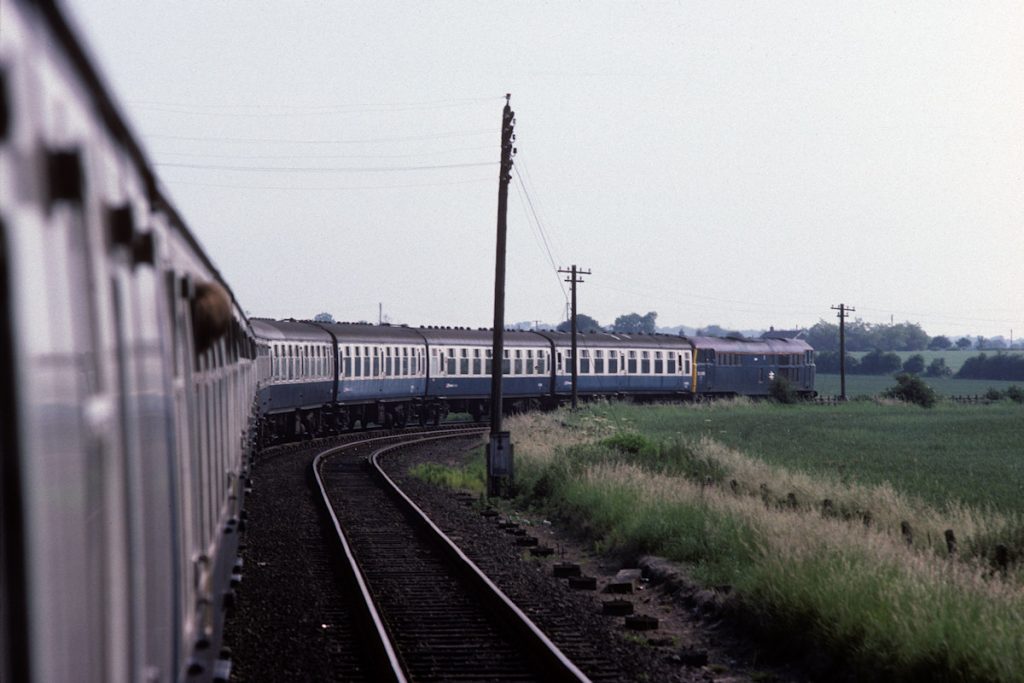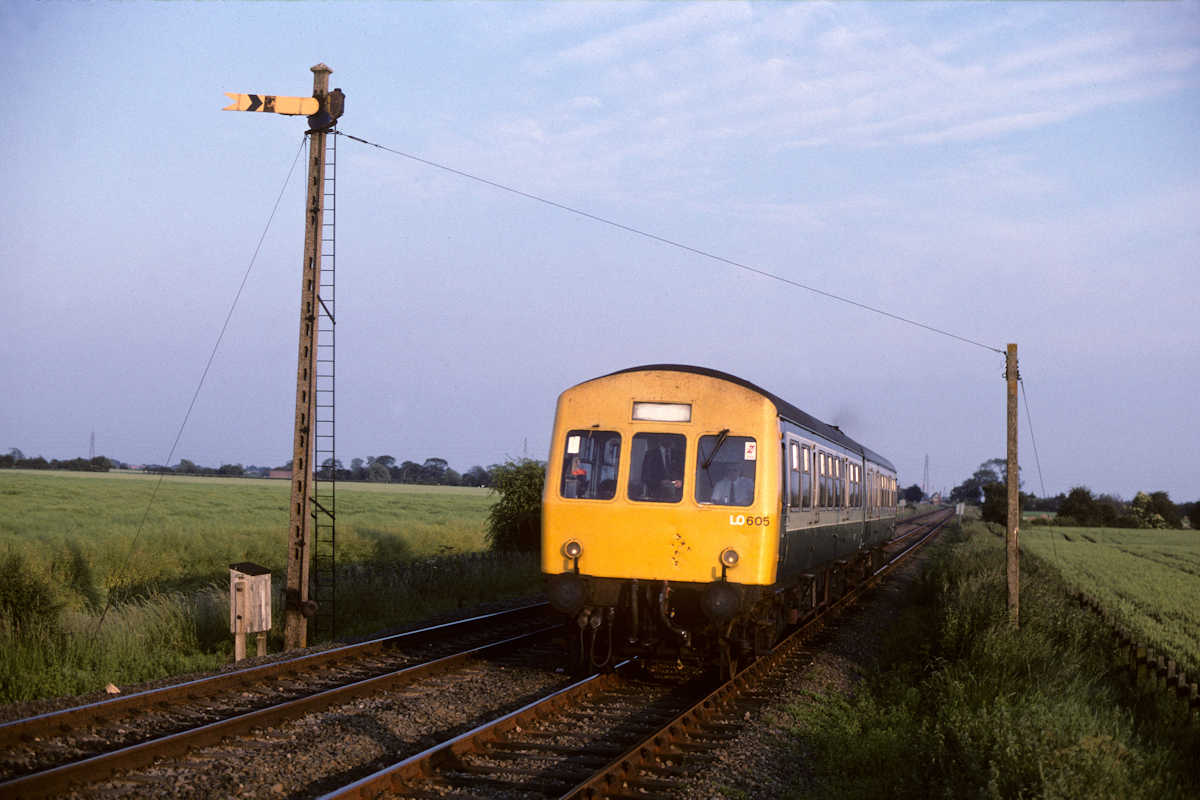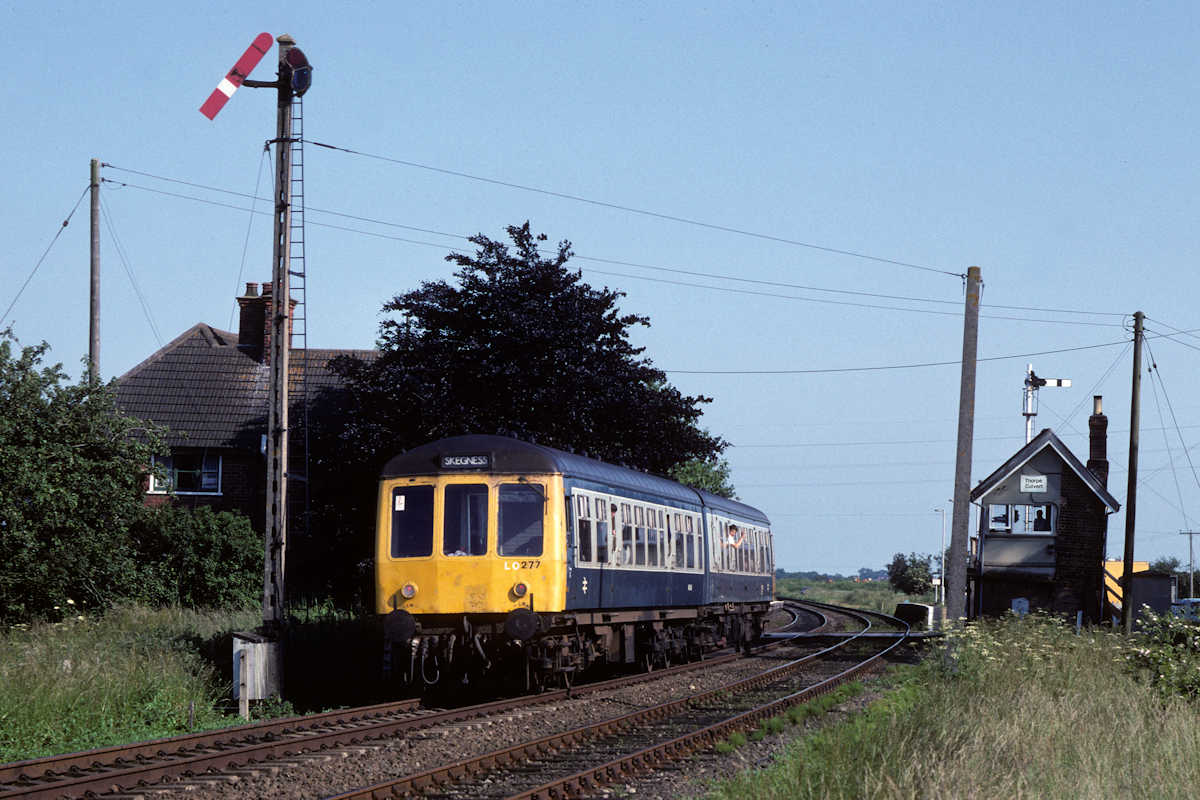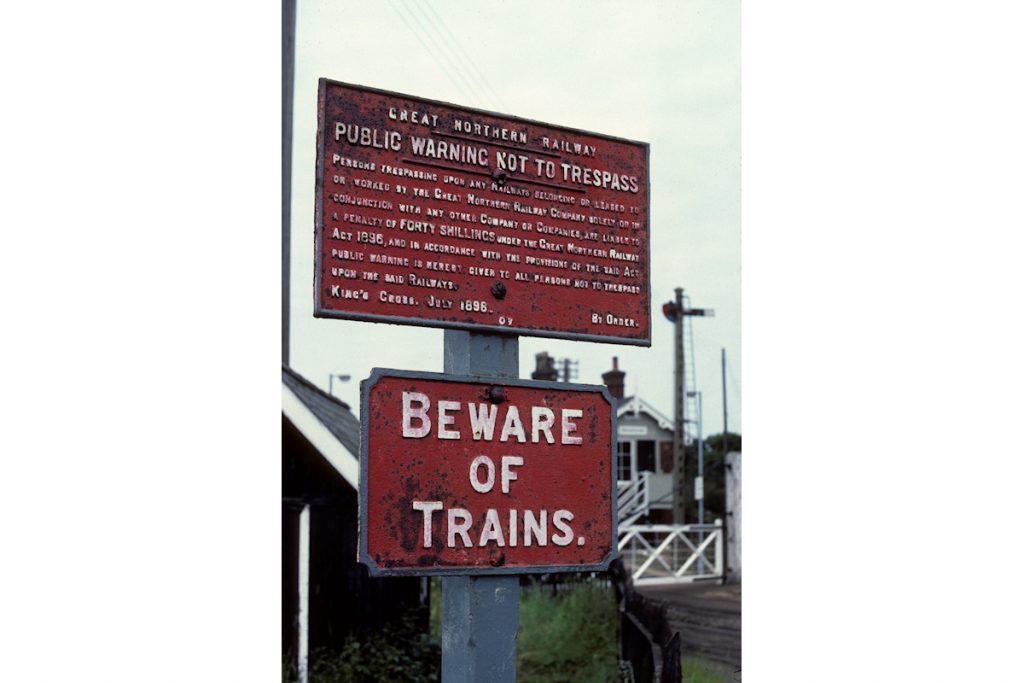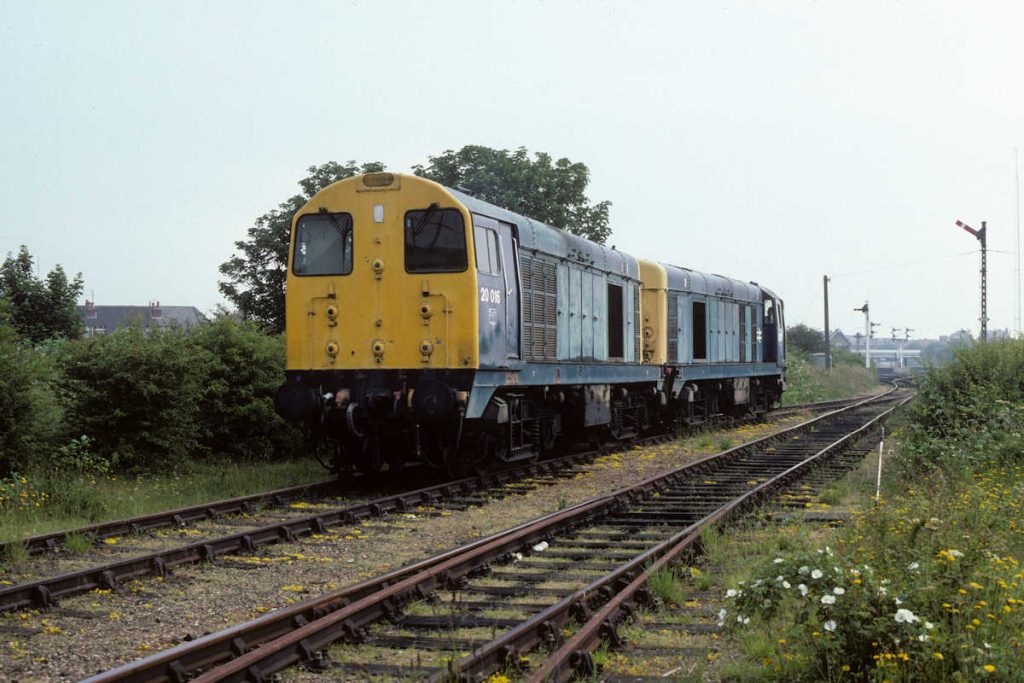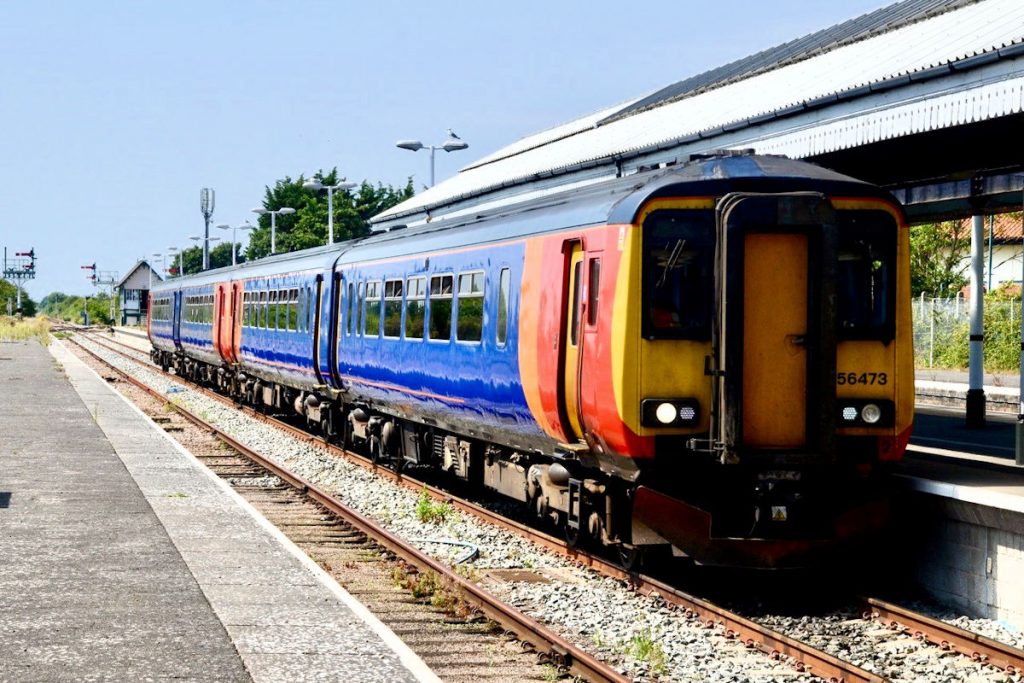Firsby, Thorpe Culvert, Wainfleet, Havenhouse, Seacroft and Skegness
Firsby
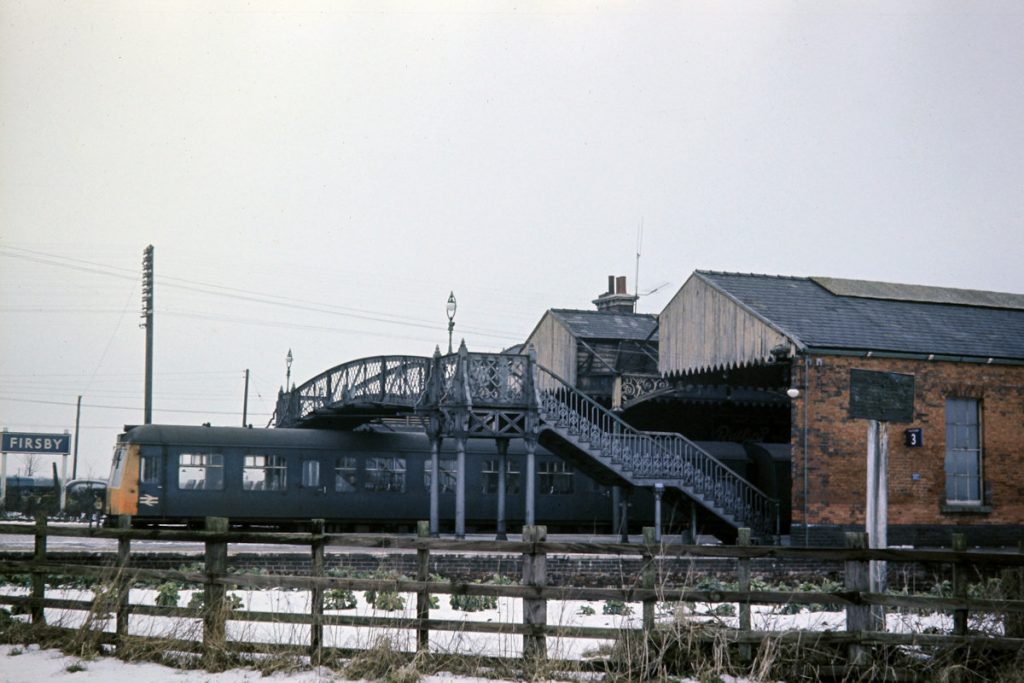
On February 19th 1970, the Skegness Branch train waits patiently at Firsby for custom before departing at 15.02. The lavishness of the infrastructure is well illustrated with the footbridge which contrasts today's minimalist functional approach. The curve round to the Skegness Branch was single line, and track-circuited. It could be accessed from either Platform 1 (Down Main) or Platform 3 which was a loop off the Up Main (the Platform 3 sign is visible on the wall of the station building) but there was no direct access from the Up Main (Platform 2). Photo: John Tolson, courtesy Trevor Davis.
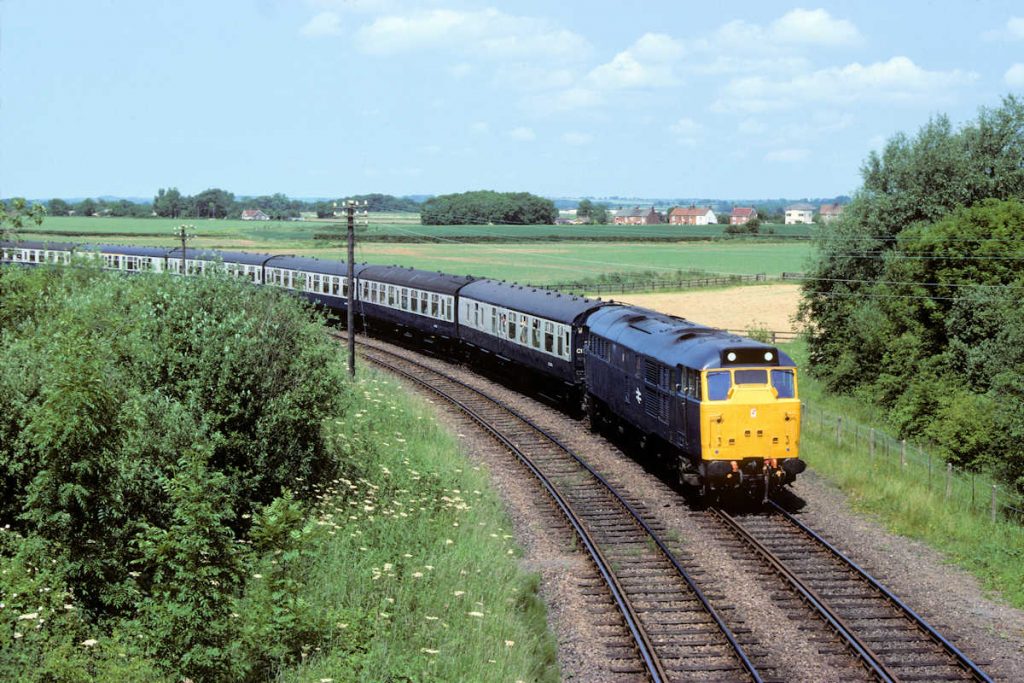
The line to Firsby station used to continue round to the right, behind the locomotive and into Firsby station, but once the railway had closed and been lifted the land was soon turned back to farmland and all traces of the line disappeared. Fresh from overhaul, a very smart 31168 and its rake of Mk 1 stock squeal round the remaining part of the triangle at Frisby with the 09.21 (SO) Leeds to Skegness on June 25th 1983. Photo: Alan Jones.

The driver's attention is caught by something in the fields as the 12.58 Saturdays Only Skegness to Derby approaches Barton's Lane crossing on September 11th 1982 in the hands of English Electric Class 20s Nos. 20072 and 20172. These were both long-standing Toton engines and would have spent their days tripping coal trains around the East Midlands from places like Rufford, Clipstone, Pleasley and Denby Collieries, so a breath of fresh sea air would have been a welcome change for them - and clearly much appreciated by the haulage fans! Photo: Alan Jones.

Seen from a foot-crossing over the line, Class 47 No. 47565 creeps round Firsby curve with the 13.13 (SO) Skegness to Sheffield on August 19th 1989. At the time there were two Summer Saturday workings from Sheffield to Skegness. The first ran South from Sheffield and then via Nottingham and the Grantham Avoiding Line whilst the second, seen here, travelled East along the former Great Central line to Gainsborough then down the Joint Line to Sleaford. The third carriage is one of the thirty Mk 2C Open Seconds with Micro-Buffet, numbered in the 6500-6529 series and converted in 1980-81 from TSO vehicles by removing one seating bay and replacing it with a counter and space for a trolley. Photo: Alan Jones.

There is only one over-bridge between Boston and Skegness, at Fendyke Road in Firsby, by the former East Junction. On a hot and hazy August 19th 1989, Brush Class 31 No. 31441 (formerly 31220) slows for the 15 mph restriction round the very tight East-to-South curve with the 12.52 (SO) Skegness to Leeds. By this date, a reasonable amount of early Mk2 stock was appearing on Summer Saturday workings, displacing steam-heated Mk 1 stock and making electrically-heated Class 31/4s an obvious choice when the timings were not too demanding. Photo: Alan Jones.
Thorpe Culvert
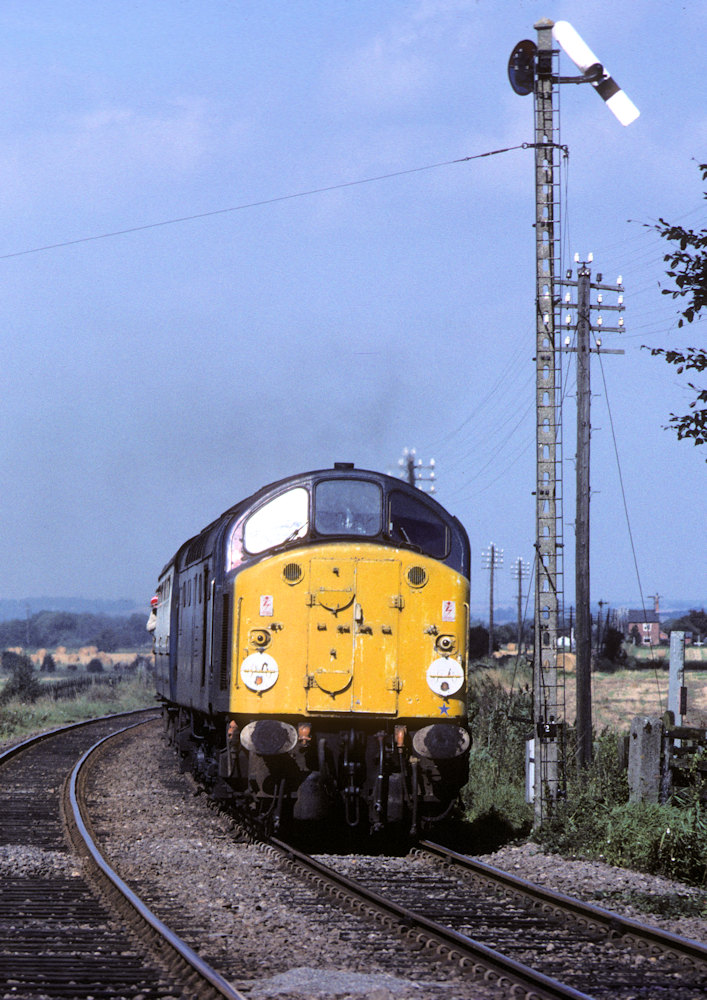
On a hot Saturday September 11th 1982, English Electric Class 40 No. 40030 (formerly named Scythia) powers through Thorpe Culvert past the Down Home signal with the 08.18 (SO) Manchester Piccadilly to Skegness. Photo: Alan Jones.
On July 6th 1991, Metro-Cammell set LO605 (53171+51253) works the 19.27 Skegness to Nottingham past Thorpe Culvert's Down Distant. Photo: Alan Jones.
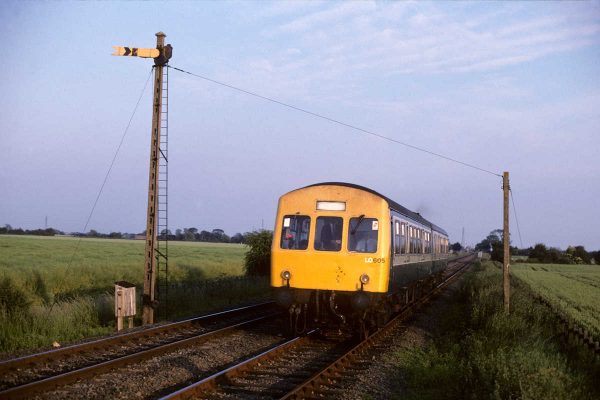
On a warm and sunny July 6th 1991, Longsight-based Derby Class 108 unit LO277 (54246+53982) draws into Thorpe Culvert with the 14.57 Nottingham to Skegness. Photo: Alan Jones.
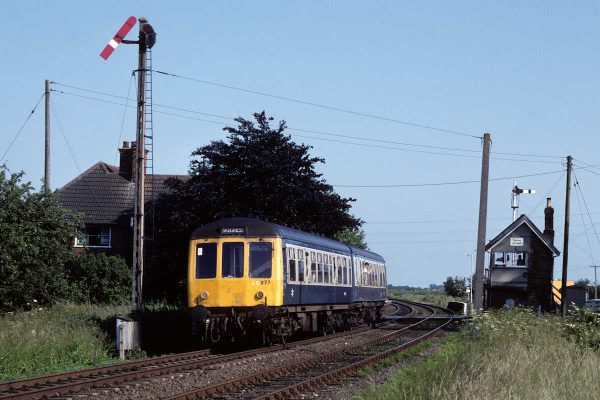
Wainfleet
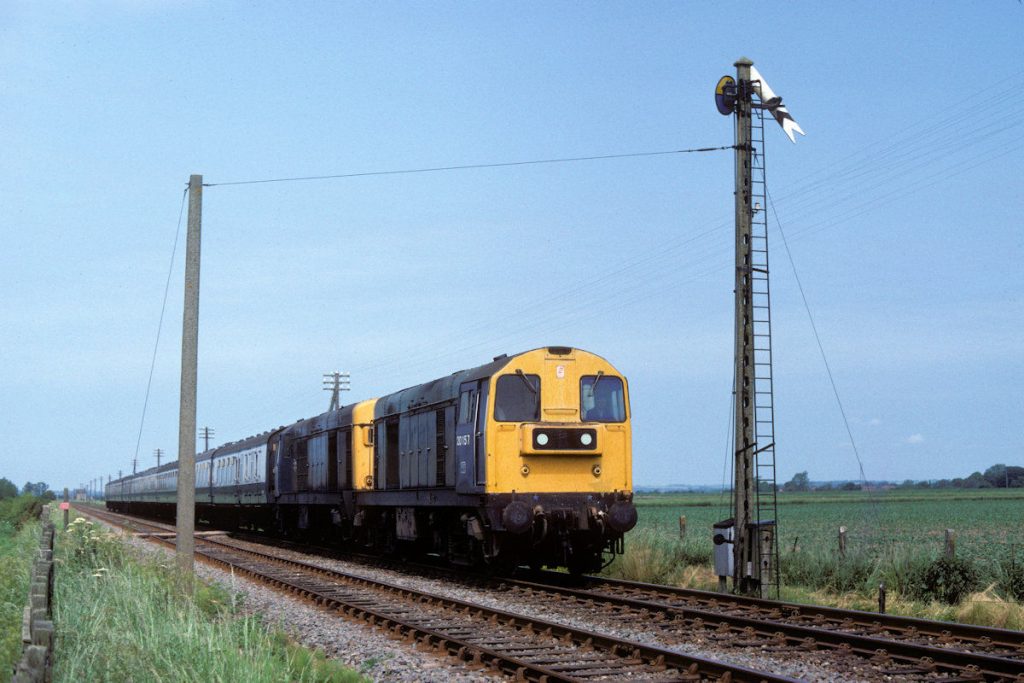
A view that perhaps epitomises the Skegness in the early 80s: a pair of Toton Class 20s passing a Somersault signal on the Leicester to Skegness, formed entirely of Mark 1 stock. The date is June 25th 1982, the location is Wainfleet's Down Distant and the locomotives are 20157 and 20135. The former was a lifelong Toton resident, whilst 20135 began life at Bescot, transferring to Toton in October 1969 where it remained for its BR service. Photo: Alan Jones.
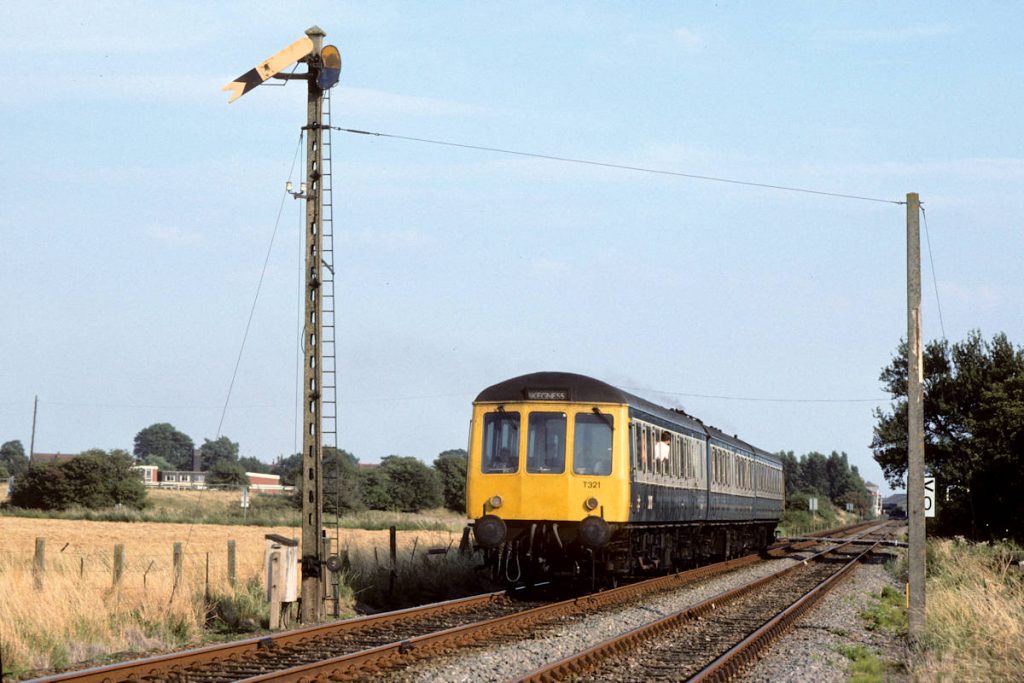
The numerous foot crossings and low fences on the Skegness Line in the 1980s made photography a very simple and enjoyable activity. From one of the crossings to the West of Wainfleet station, the afternoon sun illuminates the rear end of Tyseley Class 116 set T321 (53854+59723+53907) as it slows for its station stop with the 14.18 Derby to Skegness on August 19th 1989. Photo: Alan Jones.
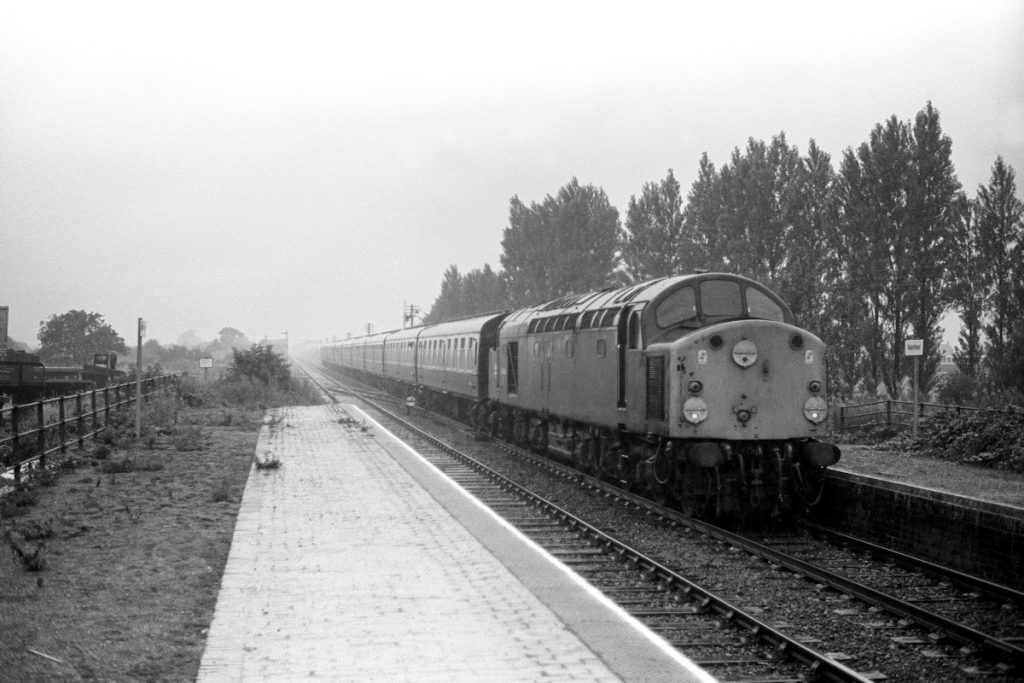
Not the most auspicious start to a week's holiday in Skegness - in a downpour of monsoon proportion, 40044 is running 90 minutes late with the 08.15 (SO) Manchester to Skegness as it slows for the tight curve at Wainfleet on August 4th 1984. The leading end of the locomotive, without doors, was rebuilt following the locomotive's accident at Chinley in 1978. Photo: Alan Jones.
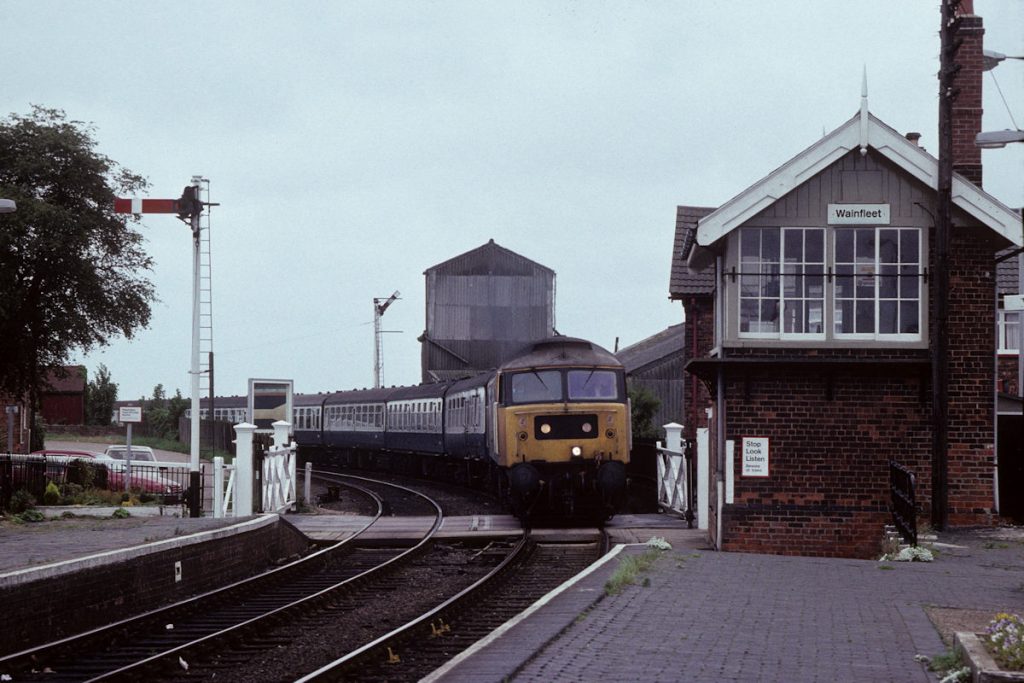
Like Firsby, there is a 15 mph speed restriction round the very tight curve at Wainfleet. With flanges squealing, Brush Class 47 No. 47465 takes it slowly round the curve and into Wainfleet station on a very dull and gloomy 9th September 1989 with the 12.52 (SO) Skegness to Leeds. Photo: Alan Jones.
Havenhouse
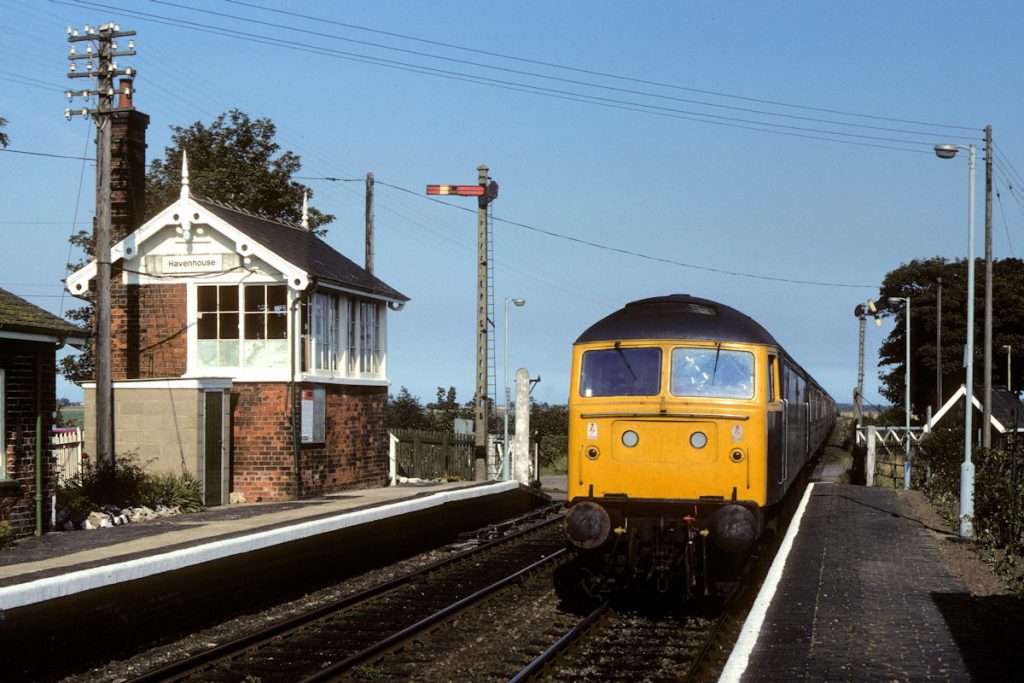
Returning to Peterborough with the stock of the through Summer Saturday train from Kings Cross, Class 47 No. 47144 heads through Havenhouse with 1B60, the 15.35 from Skegness on September 11th 1982. Both metal and wooden Somersault arms were to be found on the Skegness Line, with metal versions in use on the Up and Down Home signals at Havenhouse. Photo: Alan Jones.
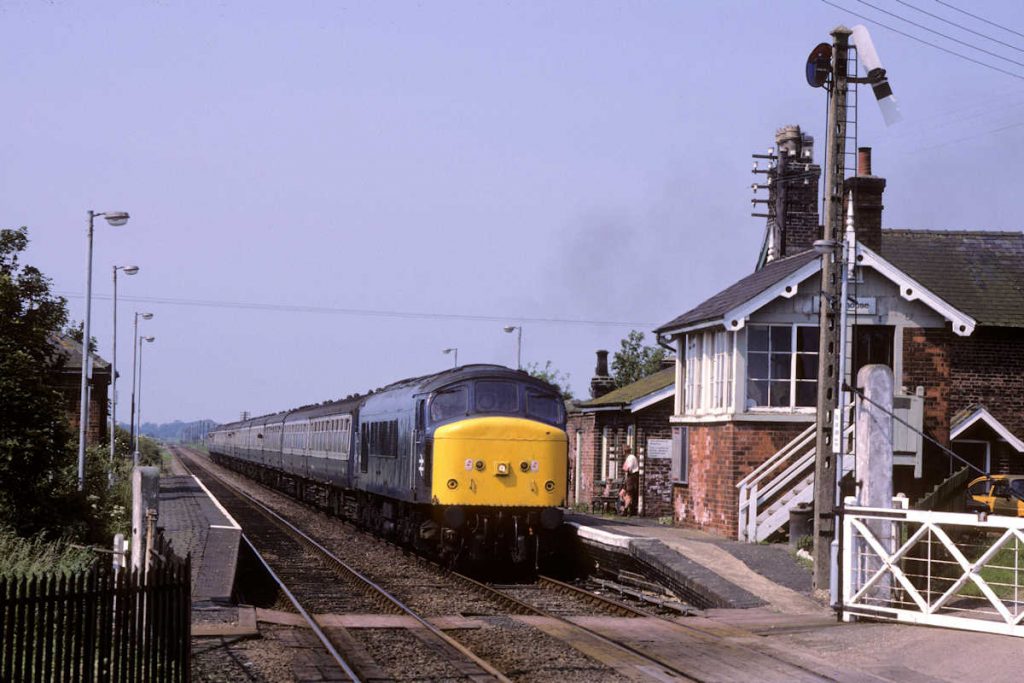
For many years one of the first Summer Saturday trains of the day to reach Skegness was 1E07, the 07.07 from Sheffield via Nottingham. It was generally a Class 45 Peak, although occasionally it would produce a pair of Tinsley Class 20s. On a scorching hot July 4th 1987, 45150 had the honour and the driver applies a little throttle to regain speed after a signal check from the Havenhouse signalman. Photo: Alan Jones.
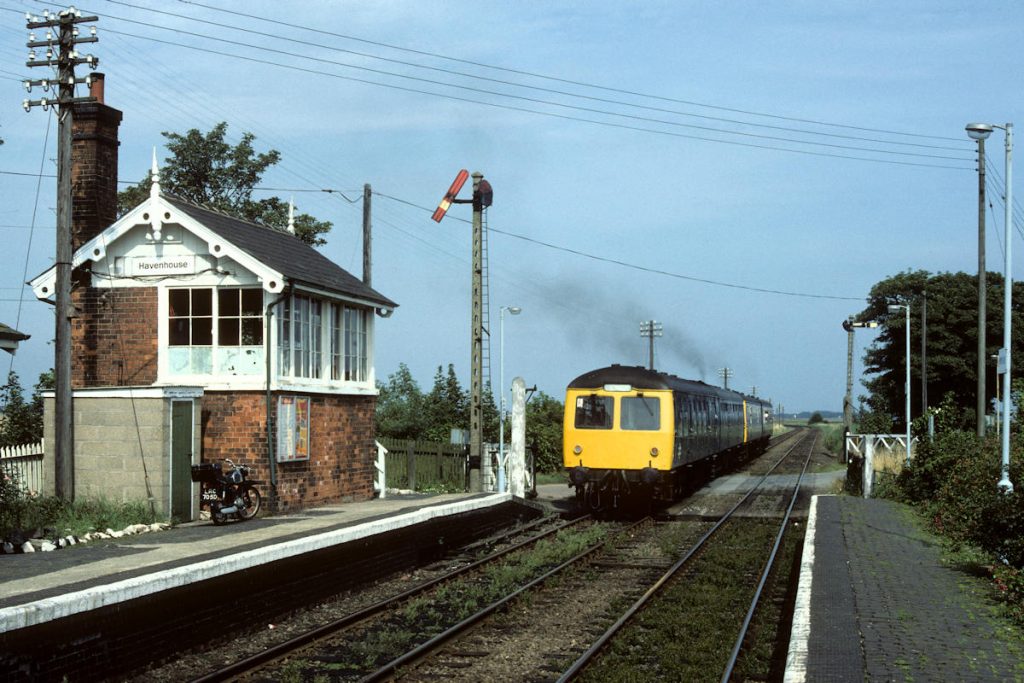
In the 1980s, Havenhouse was an operational museum of Great Northern Railway signalling and as such was a delightful place to spend a few hours on a sunny Summer's afternoon. The museum feel is complemented by the signalman's 1966 Honda 90cc motorcycle. Pre-dating this by eight years, 1958-built Class 105 Cravens set E51259 and E54434 brings up the rear of the 12.41 Nottingham to Skegness on August 18th, 1984. Photo: Alan Jones.
Seacroft
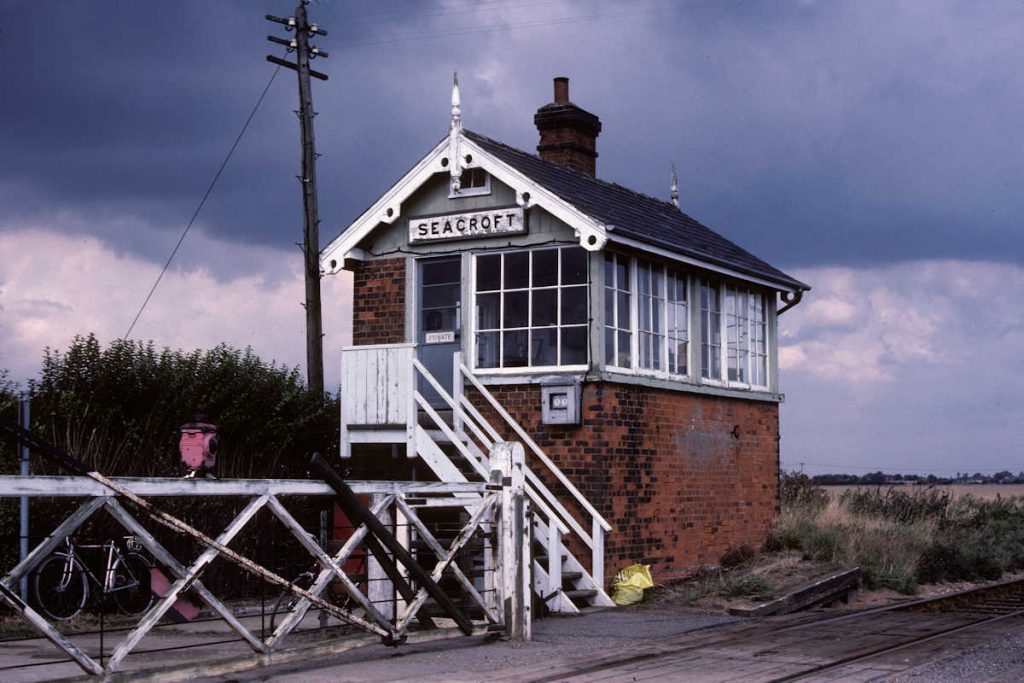
Seacroft station closed as early as 1953, and the remains of the platform ramp can be seen in this view taken thirty years later on September 17th 1983. The Signal Box remained in situ until the early 90s, when BR carried out a number of alterations to the signalling on the line, latterly to control the crossing of a minor road to a few farms. Photo: Alan Jones.
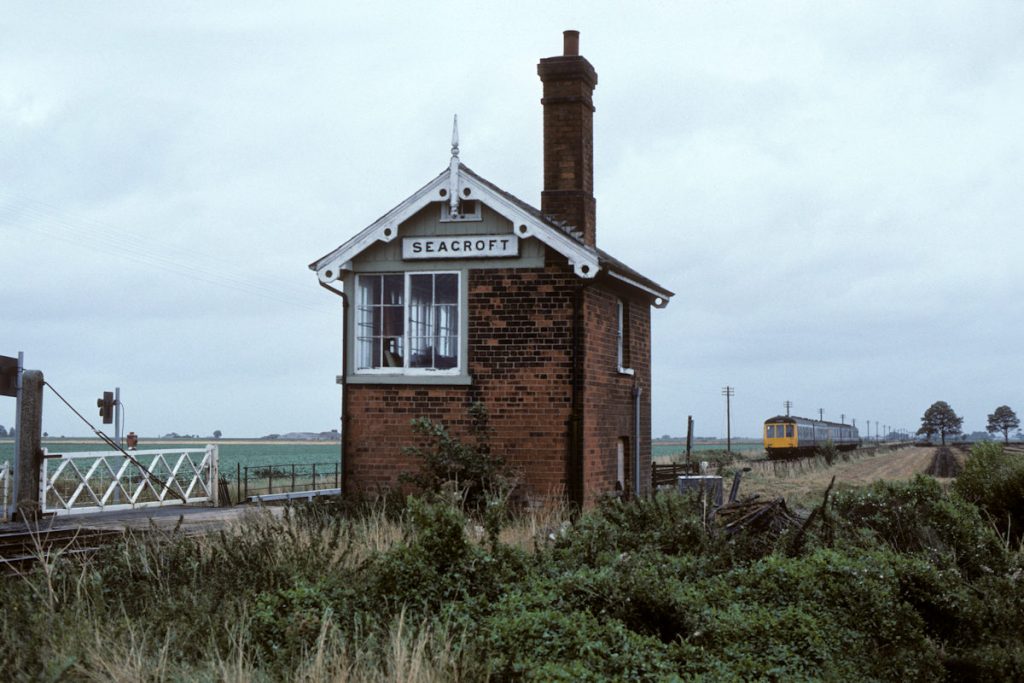
A different perspective of Seacroft Box, on September 9th 1989, showing a five-car DMU formation on the 10.46 Derby to Skegness. By this time, the timetable was in transition with several of the long-established locomotive-hauled Summer Saturday trains having ceased and the service starting to move towards a year-round pattern that remained relatively stable over the whole year. Photo: Alan Jones.
Skegness
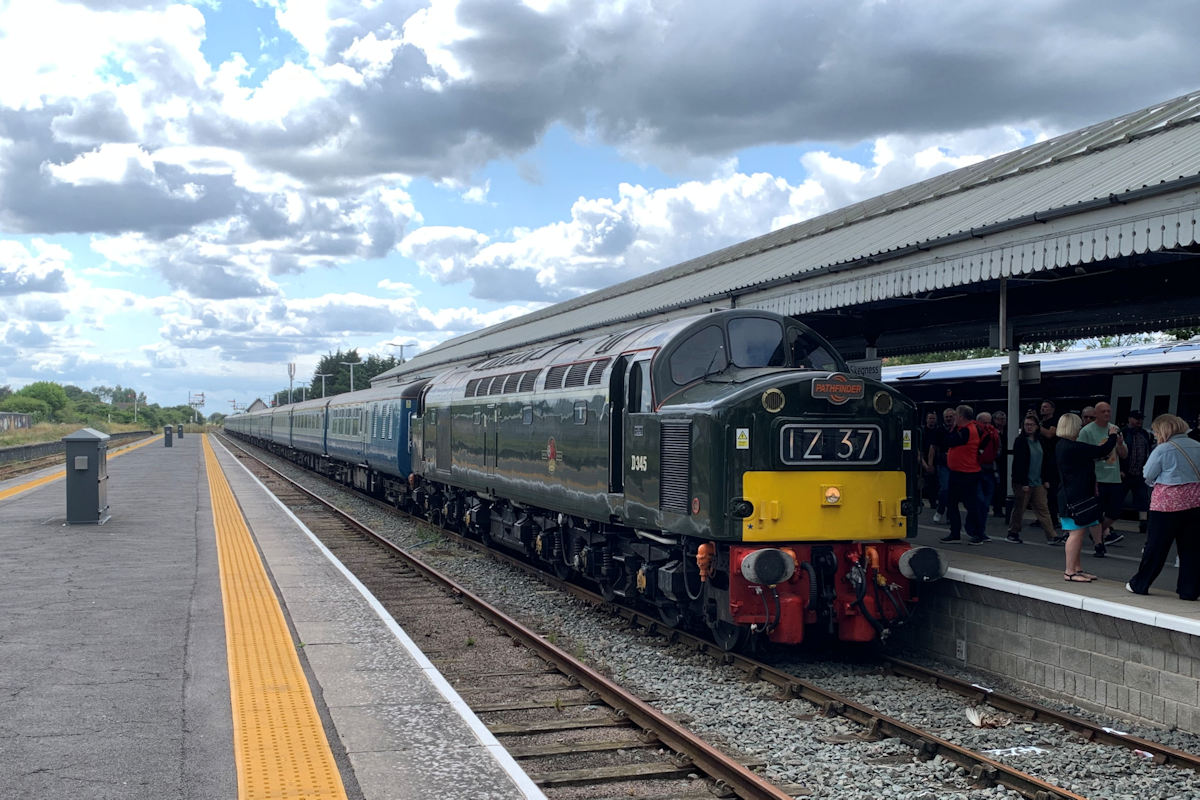
On Saturday July 27th 2024, beautifully-restored English Electric Class 40 No. D345 (40145) is seen at Skegness after arrival with 1Z37, Pathfinder Railtours' "The Jolly Whistler" from Burton-on-Trent. The tour travelled via Birmingham New Street, Wolverhampton and Crewe to Manchester Victoria via Chat Moss and then over the OA&GB to Stockport, Sheffield and the GC and Joint Line to Sleaford and Skegness. The return suffered some delay due to problems with the run-round in the carriage loop at Skegness, but a splendid day of vintage traction to the Coast was enjoyed by all. Photo: Jeremy Hunns.
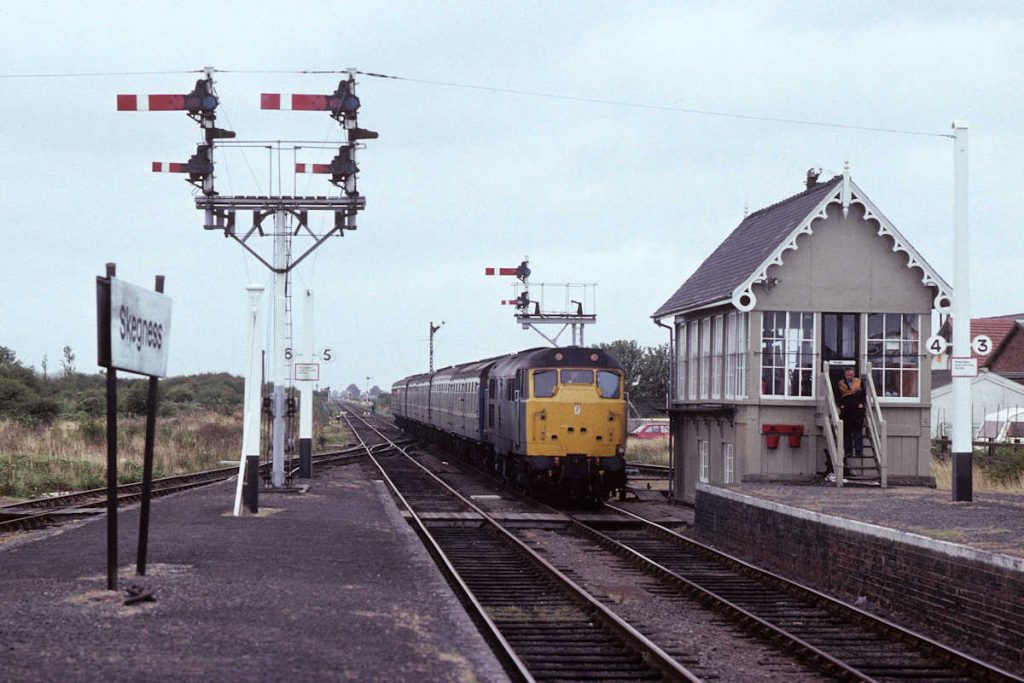
For most of the year Skegness station saw little activity, with little more than a two-car DMU every two hours. But on Summer Saturdays it came to life with locomotive-hauled trains, propelling movements, running round and the rusty outer platform lines brought into use. The shunter has just finished a cup of tea in the signal box and heads down to the platform to meet 31422 arriving with the 07.30 (SO) from Birmingham New Street on September 9th 1989. He will join the train at the rear and wave it out of the station into the carriage sidings, then run the locomotive round and wave the train back in as it reverses into the station. Photo: Alan Jones.
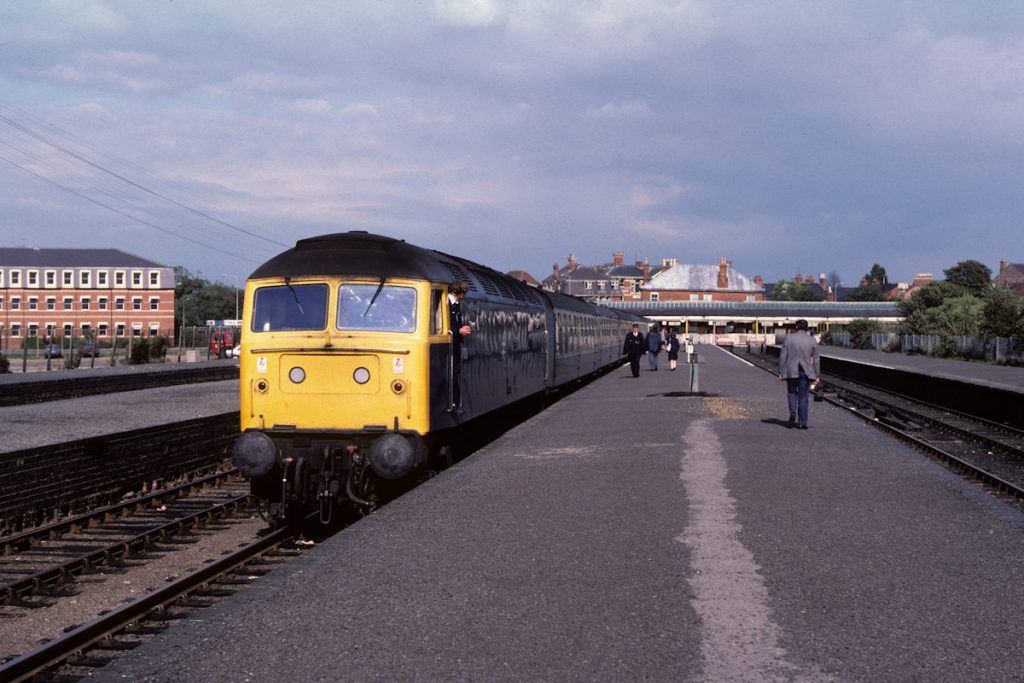
In the early 1980s the last Summer Saturday working of the day from Skegness was 1B60, the 15.35 to Peterborough. It was generally a boilered class 47 and was the return working of the through train from Kings Cross earlier in the day. Collecting its last few passengers on September 17th 1983, the last day of the season, 47018 waits for departure at the now-deserted station, which will come back to life again on Saturday May 19th 1984 when the new timetable begins. Photo: Alan Jones.
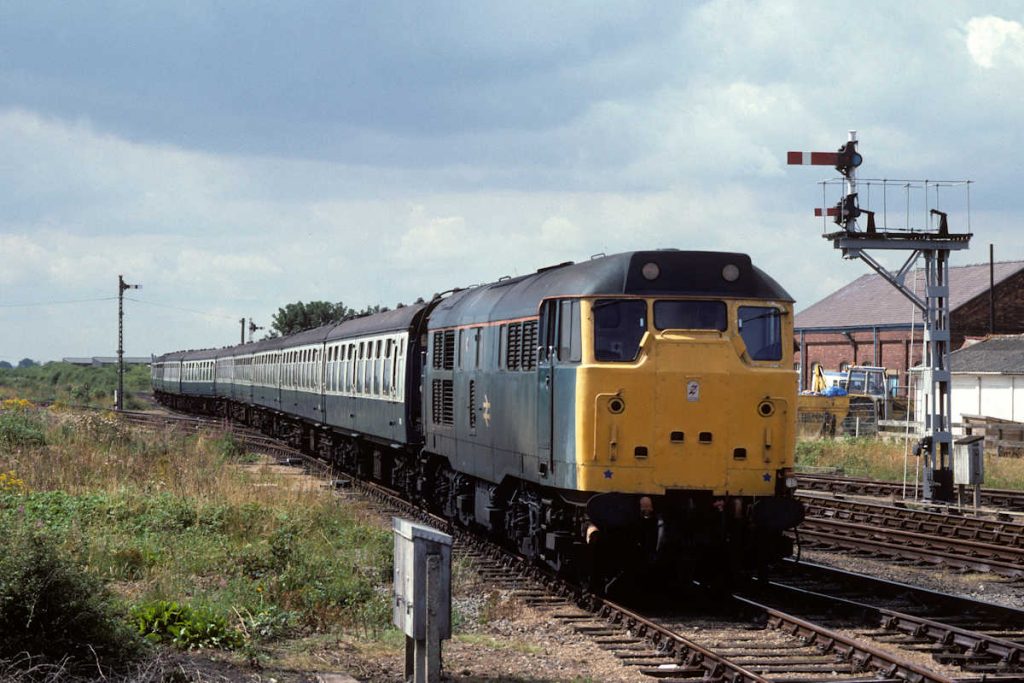
Brush Class 31 No. 31441 has arrived into the little used Platform 7 at Skegness with the 08.34 (SO) from Leeds on August 12th 1989. The train has been emptied and is being propelled into the carriage sidings over the slips at the throat of the station. Here, it will run round and then propel back in. The allowances for a run-round manoeuvres at Skegness were generally in the region of 40-60 minutes, so although perfectly possibly, it did require some smart work from the staff involved. Photo: Alan Jones.
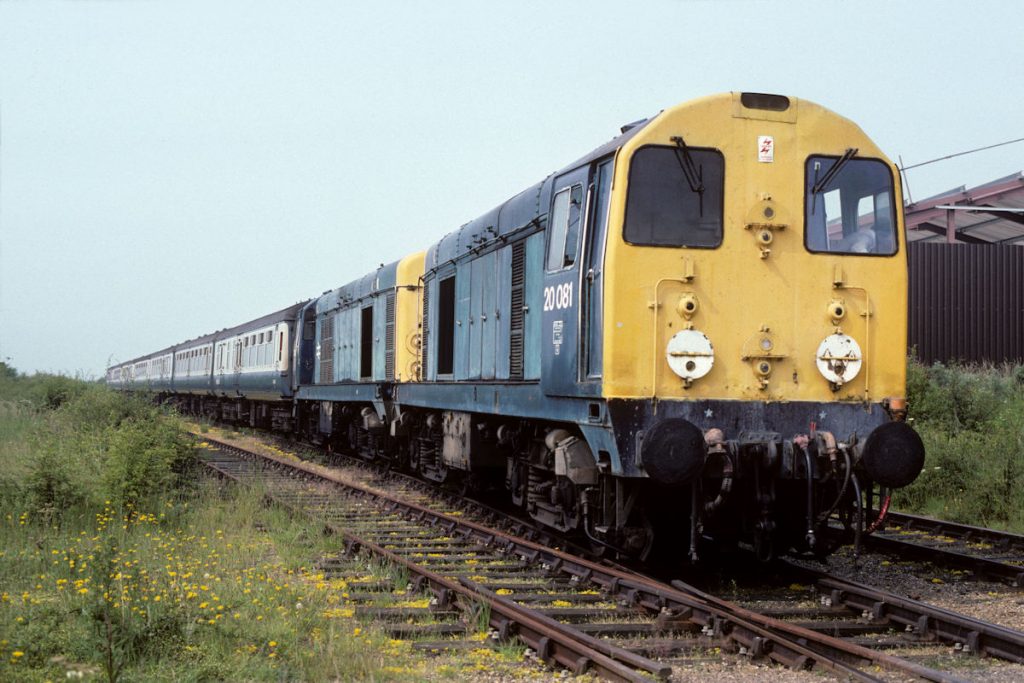
A very pleasant surprise occurred at Skegness on Saturday July 6th 1991 with the arrival of 20081 and 20016 on the 06.30 from Sheffield via Nottingham. The pair is seen in the Carriage Sidings after propelling out. They are being uncoupled and will run round, couple-up and propel back into the station. A very tight 34 minutes were allowed for all of these manoeuvres, between arrival at and departure from the station. Photo: Alan Jones.
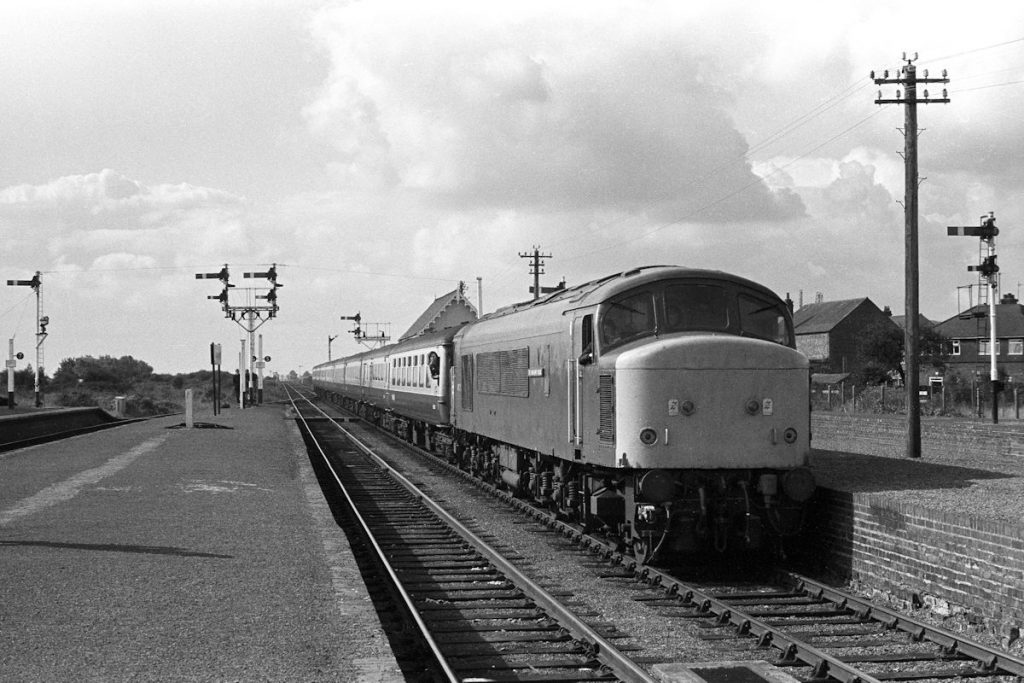
Class 45/1 No. 45123 'The Lancashire Fusilier' looks smart as it arrives into Skegness station on September 17th 1983 with the 09.22 from Derby. Apart from the leading vehicle, the stock is air conditioned Mark 2, recently displaced from the Midland Main Line by the arrival of High Speed Trains. It did not last long on such lowly duties, being redeployed onto other Inter-City services later in the year. Photo: Alan Jones.
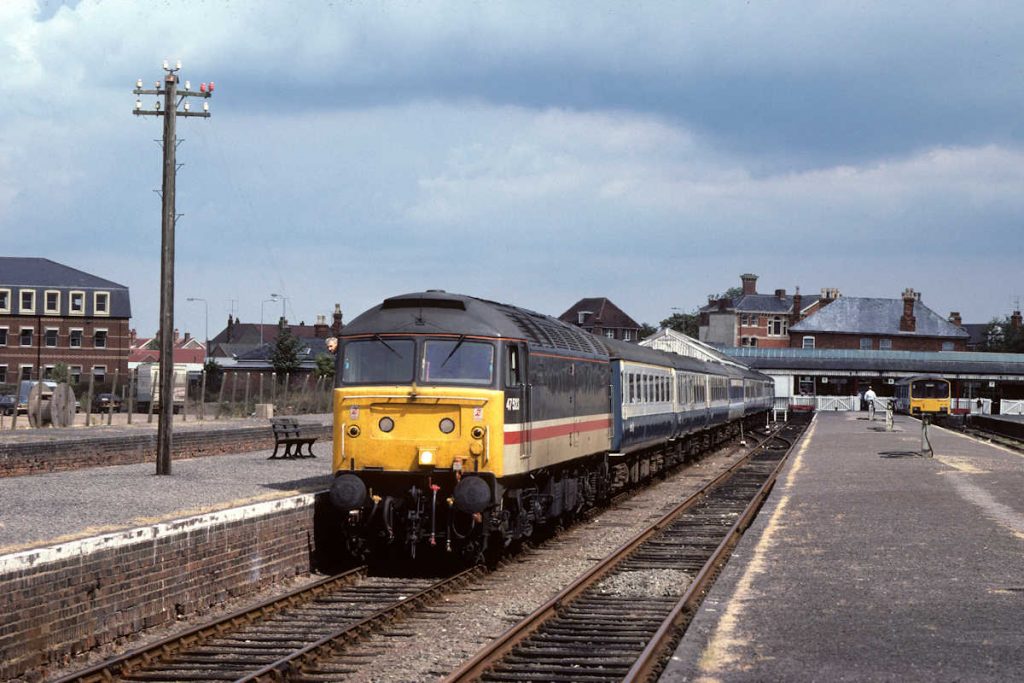
Enjoying a brief period of sunlight before the heavy cloud came in, the driver of 47523 checks up and down the platform prior to departure with the 13.13 (SO) to Sheffield on August 12th 1989. In 1989, there were two Summer Saturday trains to Skegness. The first left Sheffield at 06.32 and ran via Nottingham and the Grantham Avoiding Line. The second (seen here) departed at 09.19 and ran via the Great Central and the Joint Line to arrive in Skegness at 12.43. It then had a very short run round of 30 minutes before returning to Sheffield at 13.13, again via the Joint Line and the GC. Photo: Alan Jones.
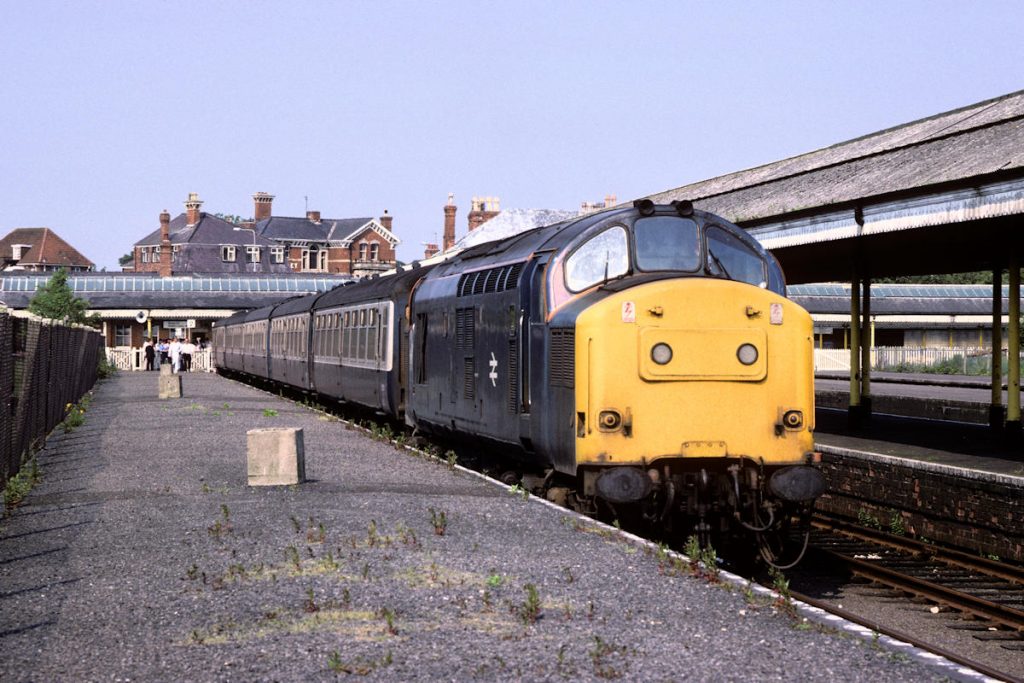
In the late 1980s an additional Summer Saturday working was laid on from Grantham to Skegness and back using the delightfully named 'Grantham Ballast Engine' - in practice a Class 37 allocated to Civil Engineer's duties. The working made a very welcome addition to services and on Saturday July 4th 1987, 37153 waits at Platform 2 for its return run as staff prepare to let passengers board. Photo: Alan Jones.
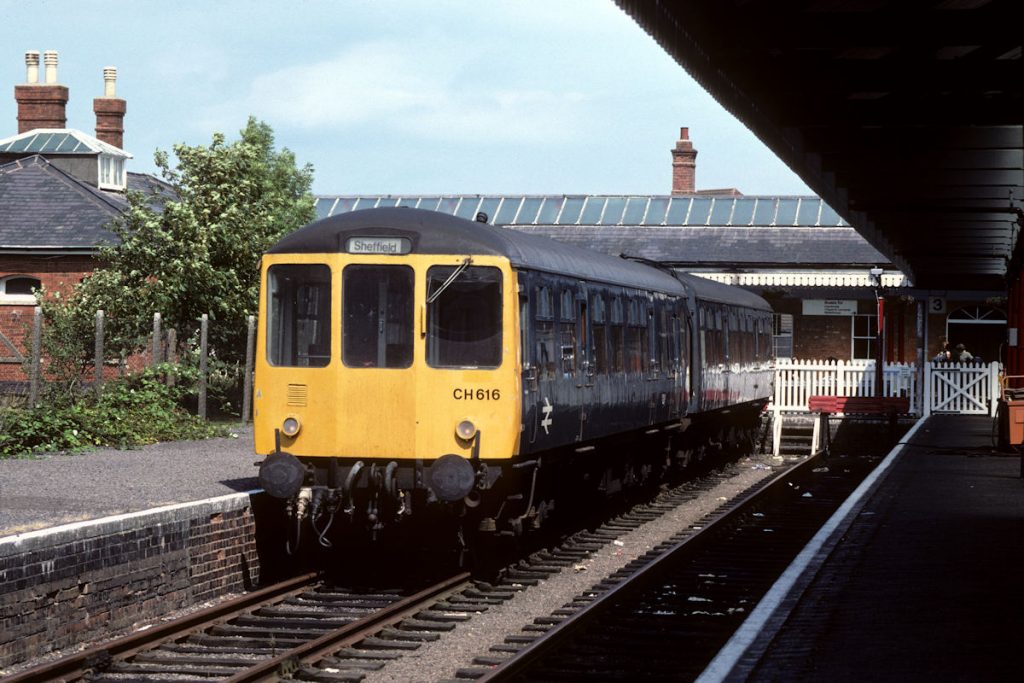
BRCW Class 104 units were never common visitors to Skegness, even when the Eastern Region had an allocation of them. However, on Saturday August 12th 1989, Chester power-twin set CH616 (M53541+M53522, both former veterans of Newton Heath) have made it to the East Coast and rest in Skegness's Platform 2 before heading back to more familiar territory with the 15.15 to Nottingham. Photo: Alan Jones.
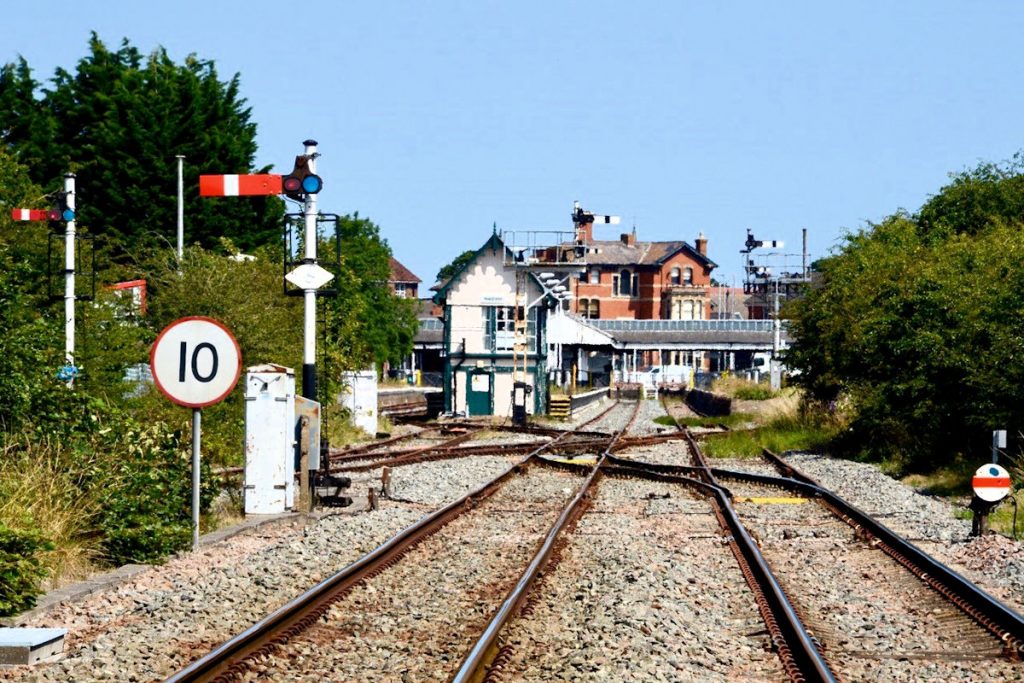
Skegness station, seen on August 4th 2021, still retains much of its semaphore signalling, although only platforms 2 and 3 remain in regular use with platforms 1 and 4 nominally available but now essentially unused. The former engine release points at the buffer stops in the station have been removed and any locomotive-hauled working requiring run-round propel out of the station into the loop to the left of the picture, which occupies the site of once-extensive carriage sidings, Photo: Michael Smyth.
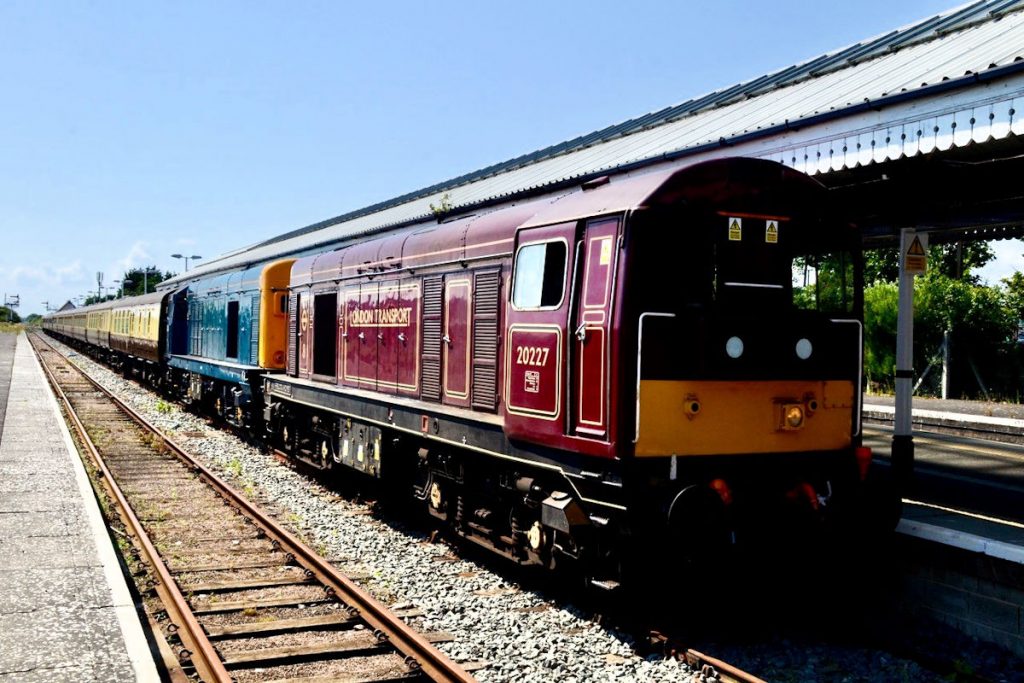
In the 1970s and 1980s, Skegness was a popular destination for Summer Saturday holiday trains originating in the Midlands, for which pairs of Class 20s were often the motive power of choice. On August 4th 2021, the Tyseley Locomotive Group re-enacted one of these in the form of 1Z85, the 07.29 Tyseley Warwick Road to Skegness, seen on arrival behind 20227 and 20189. Photo: Michael Smyth.
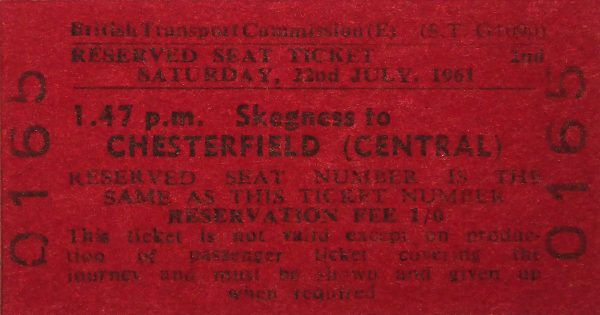
During the 1950s and 60s Summer Saturday passenger loadings from seaside resorts were so great that strict ticket regulation was needed. Seat reservation tickets were printed for specific trains on specific days, giving an indication of the scale of the operation! This example is a reservation ticket for the 1.47 pm Skegness to Chesterfield Central on Saturday 22nd July 1961 - an interesting working that travelled via Woodhall Junction, Lincoln Central, Torksey and round the Waleswood Curve on to the Great Central. Photo: Alan Jones.

